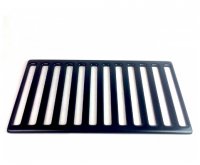Ok, to make things worse, I did a second, totally not scientific test ;-) As said before, so many variables that can't be controlled, or I just don't feel like controlling, but still, I think very interesting results:
Some background info:
After my first test (sensor halfway down the front wall), I repeated the test with the sensor halfway down the back wall.
- Fridge set to 'Max'
- Started with fridge 'off'
- Outside max temperature at 23 (so much colder then in test1)
- Started with an empty fridge and later added food (most pre-cooled in home fridge)
- Van parked in the shade for the first 1/3 of the test.
- Van on leisure batteries, on hookup for 10 min. Then drove the van and then camped and had it on EHU.
- Opened the fridge several times while camping; normal use.
The most interesting thing is that
I am seeing a minimum temperature of around -14c celcius. The second and most important thing is that
I am seeing circa -12c constantly with no problems what so ever, while camping, thus using the fridge like you would in a real life camping situation. What surprises me the most is the huge difference between test1 (sensor halfway down the front wall) and test2 (sensor halfway down the back wall).
During test 1, on a hot day the sensor (front wall) measured 8c as the worst temperature with an empty fridge. So just above the 4-6c 'safe' temperature range.
During test 2, on a warm day, the sensor (back wall) measured -3c as the worst temperature with a filled fridge and was basically steady at -12 all the time.
That's a huge difference between front wall and back wall. And yes, the weather was different, but still.
For now I am concluding that there is a big difference between temperatures in the front of the fridge and in the back. Something that I had already noticed before starting testing. And, I do believe that the outside temperature (or better yet, the temperature inside the van) plays a big role as well.

















